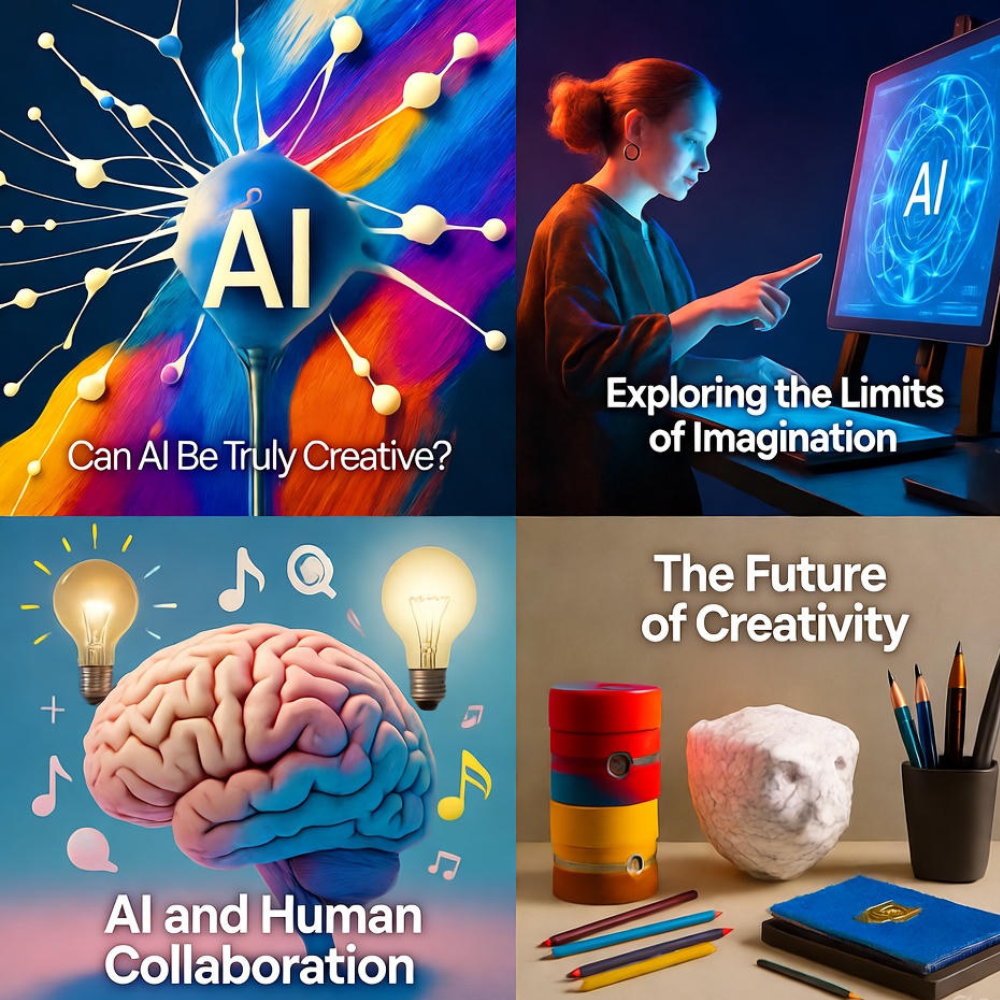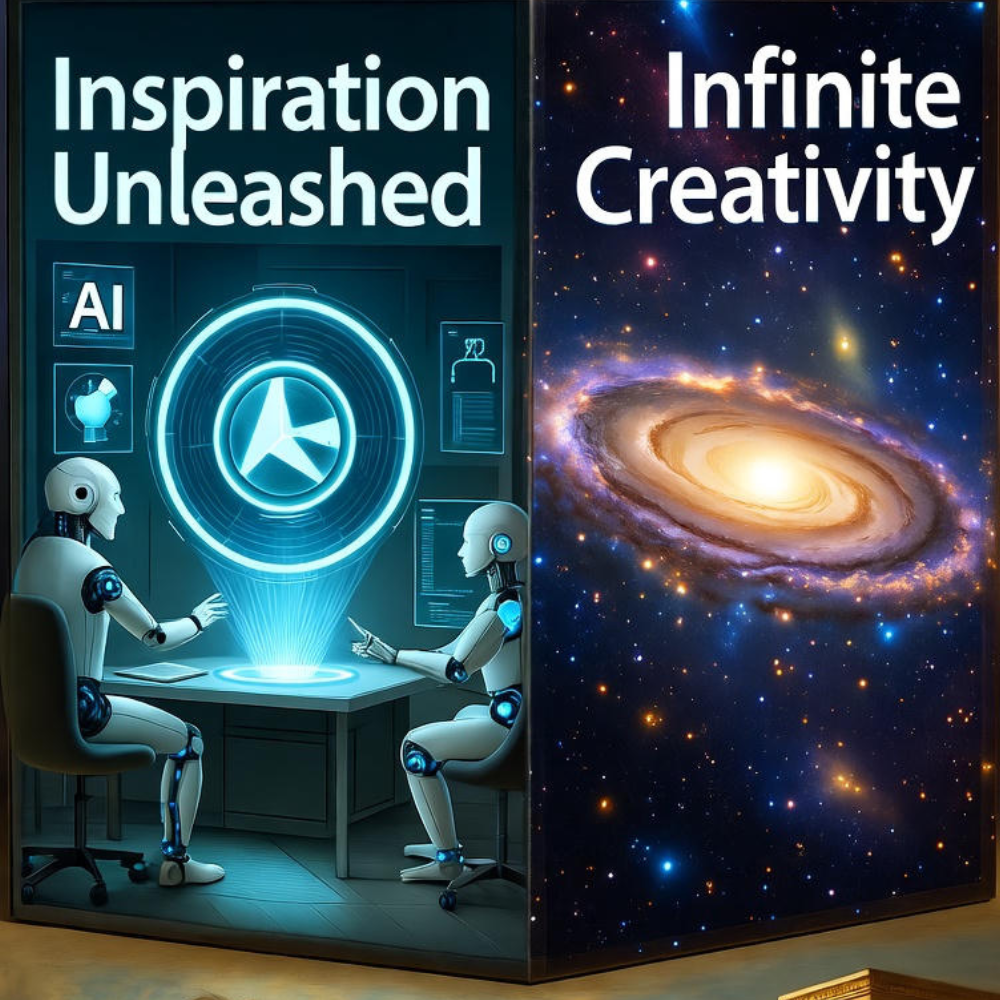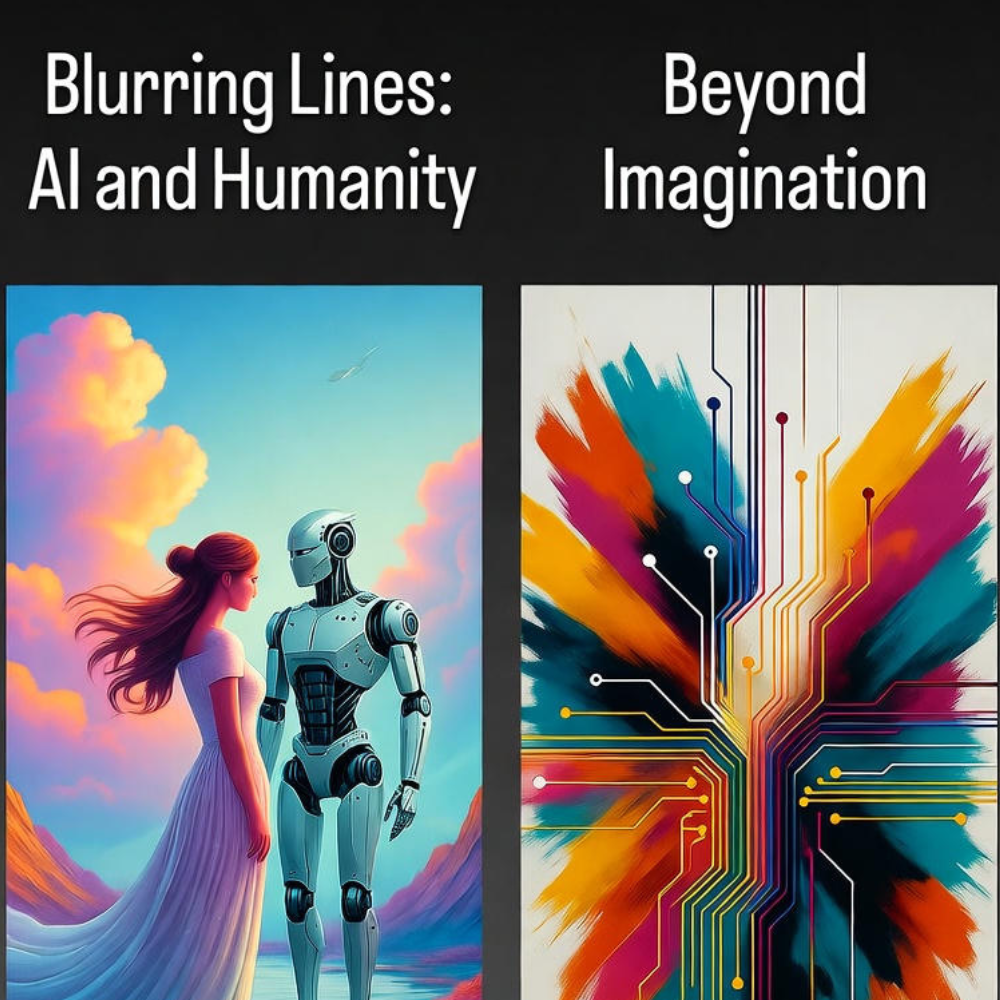
Introduction
When we think of creativity, we imagine human qualities — emotion, intuition, and the spark of inspiration that turns a blank page into poetry or an empty canvas into art. Yet, in today’s AI-driven world, machines are producing paintings, composing music, and writing stories that could pass as human-made. This raises a fascinating question: Can AI truly be creative, or is it simply mimicking human creativity?
As artificial intelligence continues to evolve — with models like GPT, Midjourney, and DALL·E producing impressive outputs — the line between human imagination and machine-generated creativity becomes increasingly blurred. But beneath the surface of this technological marvel lies a deeper inquiry into what creativity really means — and whether a machine, built on data and algorithms, can ever imagine in the same way we do.
In this article, we’ll explore the heart of this debate — dissecting how AI “creates,” what creativity truly entails, and whether machines can ever surpass the limits of programmed imagination.
1. Understanding Creativity: The Human Element
Before we can judge AI’s creative potential, we need to define what creativity really is.
At its core, creativity is the ability to produce something original, valuable, and meaningful. It involves:
- Divergent thinking — seeing connections others might miss.
- Emotional depth — expressing human experiences and feelings.
- Intentionality — having purpose or motivation behind creation.
- Cultural understanding — creating within and beyond human context.
Human creativity is deeply tied to our consciousness, experiences, and emotions. A writer draws from heartbreak, an artist from observation, a musician from nostalgia. These are not just patterns — they’re lived experiences infused into art.
AI, however, lacks lived experience. It doesn’t feel joy, sadness, or wonder. So how can it create something that resonates with emotion?
2. How AI “Creates”: The Algorithmic Artist
Artificial Intelligence doesn’t create in the human sense — it generates based on patterns it has learned from vast datasets. Let’s break it down simply.
How AI Creativity Works
- Data Input: AI models are trained on millions of examples — text, images, music, etc.
- Pattern Recognition: The system identifies styles, structures, and relationships between elements.
- Generation: When prompted, AI combines learned patterns to produce a new, yet statistically probable, output.
- Feedback Loop: Some models improve via user feedback or reinforcement learning.
For example:
- ChatGPT writes by predicting the most likely next word based on context.
- DALL·E creates images by combining visual concepts in novel ways.
- AIVA composes music by learning from centuries of classical compositions.
This process appears creative, but at its essence, it’s a complex remix of existing data — not genuine imagination.
3. The Illusion of Creativity: When Machines Imitate Art
When AI produces something “new,” it’s easy to assume it’s creative. After all, a poem generated by an algorithm can evoke emotion. But the illusion of creativity lies in how we interpret the output, not in the machine’s understanding of it.
For instance:
- An AI can generate a love poem — but it doesn’t understand love.
- It can design a beautiful painting — but it doesn’t feel beauty.
- It can compose a symphony — but it doesn’t hear the music.
Humans, on the other hand, infuse their creations with subjective meaning. When Van Gogh painted Starry Night, it wasn’t just about patterns — it was a reflection of his emotional turbulence and wonder. AI, no matter how advanced, lacks that inner world.
In short, AI can imitate the outcome of creativity, but not the experience behind it.

4. The Spectrum of AI Creativity: What It Can and Can’t Do
Let’s look at where AI truly shines — and where it still falls short.
What AI Can Do
✅ Generate content at scale: AI can produce thousands of unique designs, stories, or melodies in seconds.
✅ Assist human creativity: It helps artists brainstorm ideas or explore variations they hadn’t considered.
✅ Combine styles innovatively: AI can merge Picasso’s style with a modern photo, creating unique hybrids.
✅ Automate repetitive creative tasks: Such as logo generation, color palette selection, or text rewriting.
What AI Can’t Do (Yet)
❌ Feel emotion or empathy: It doesn’t understand why something is beautiful or meaningful.
❌ Develop personal taste or style: It reflects the data it’s trained on — not a personal aesthetic.
❌ Originate without input: AI requires human prompts, data, and training — it doesn’t “decide” to create on its own.
❌ Challenge cultural norms: True creativity often breaks rules; AI stays within statistical patterns.
So while AI can simulate creativity impressively, it operates within boundaries defined by humans.
5. AI as a Creative Partner: The Human-AI Collaboration
Instead of viewing AI as a competitor to human creativity, it’s more productive to see it as a collaborative partner — a tool that expands what humans can achieve.
Examples of Collaboration
- Writers use AI for brainstorming plots or overcoming writer’s block.
- Designers use tools like Midjourney or Canva AI to generate ideas faster.
- Musicians use AI to experiment with new harmonies or remix tracks.
- Filmmakers use generative models to visualize scenes or test storyboards.
AI enhances creative workflows — speeding up experimentation and pushing boundaries. It’s like having an assistant who never tires or runs out of ideas, but still needs human direction to create meaning.
As one artist put it, “AI gives me the brush, but I decide the picture.”

6. The Philosophy of Machine Imagination
At the core of this debate lies a philosophical question: Can machines imagine?
Imagination requires consciousness — the ability to visualize things that don’t yet exist, influenced by emotion, memory, and intent. AI lacks all three.
AI doesn’t dream. It doesn’t aspire. It doesn’t “wonder what if.” It doesn’t experience the frustration of creative struggle or the thrill of inspiration.
Its “imagination” is purely computational — generated through probability, not possibility.
This is why many experts argue that AI’s creations are derivative rather than truly innovative. Until machines possess subjective experience — something resembling consciousness — their “imagination” will remain synthetic.
7. When AI Surprises Us: Accidental Innovation
Interestingly, there are times when AI outputs something unexpectedly brilliant — a combination no human predicted. These “happy accidents” can seem like flashes of creativity.
For example:
- A generative art model combining unrelated images might produce surreal, dream-like art reminiscent of Salvador Dalí.
- A text generator could craft metaphors that sound profound, even though they emerged statistically.
- A music AI could produce an original-sounding melody that moves listeners emotionally.
But these moments are emergent phenomena — byproducts of complex systems — not intentional creativity. The “magic” we see often reflects our interpretation, not the machine’s understanding.
8. The Ethics and Future of AI Creativity
As AI-generated content becomes more widespread, new questions emerge:
- Who owns AI-generated art — the user, the developer, or the machine?
- Should AI works be considered “original” if they’re based on human-created data?
- How do we preserve human artistry in a world of endless machine-made content?
The Future Landscape
AI will likely continue to augment creativity, not replace it. Future artists may specialize in AI-augmented design, using tools as creative extensions rather than competitors.
We’ll see:
- Personalized creative assistants that adapt to individual taste.
- Collaborative platforms where AI co-creates with humans in real-time.
- Ethical frameworks ensuring transparency about AI-generated works.
The creative world is shifting — not because AI has become human-like, but because humans are learning to create with machines, not against them.

9. Redefining Creativity in the Age of AI
Maybe the real question isn’t “Can AI be creative?” — but rather, “What does creativity mean in a world where machines can create?”
Creativity might evolve from being a purely human trait to a shared process between human intention and machine execution.
The true artistry lies in how we use AI — how we prompt, guide, and interpret it.
In this sense, the most creative act remains human: using tools to express ideas beyond our natural limits. Just as cameras changed painting and synthesizers changed music, AI will redefine — not replace — what creativity means.
Conclusion
AI may never feel inspiration or emotion, but it undeniably transforms how we create, imagine, and innovate.
While machines lack consciousness, they can amplify human creativity — helping us explore new artistic territories faster than ever before.
True creativity still belongs to humans — to our messy, emotional, unpredictable minds that dream, fail, and imagine the impossible.
AI might be the brush, the pen, or the instrument, but we are still the artists guiding it.
In the end, the question isn’t whether AI can be truly creative — it’s whether we can use its potential to push the boundaries of our own